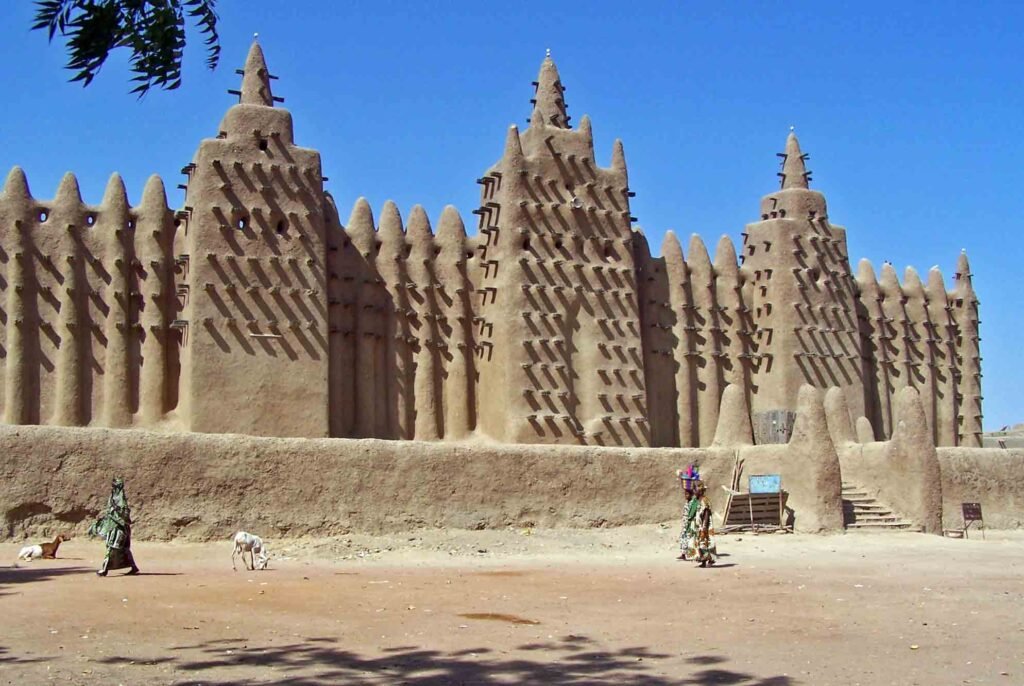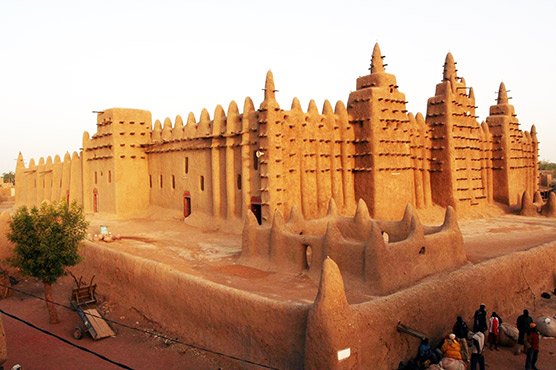In the middle of the sub-Saharan Africa lies a unique mosque which, over the years, has become the centre of knowledge for thousands of Muslims.
The Djinguereber Mosque situated in Mali’s city of Timbuktu has entirely been built from organic materials such as wood, limestone and has been rendered with mud. This mud-coloured centuries-old mosque is one of the largest in the world.
The architectural significance of this mosque is that it has been built with earthen bricks, which serves as a natural insulator to keep the inside walls of the mosque cool during the arid summers.
The Djinguereber Mosque from Koyra Chiini jiŋgar-ey beer ‘grand mosque’, also known as Djingareyber or Djingarey Ber, is a famous learning center in Timbuktu, Mali. Built in 1327, it is one of three madrassas composing the University of Timbuktu.
The Djinguereber Mosque in Timbuktu, Mali, was built in 1327 by Mansa Musa, the emperor of the Mali Empire, following his return from a pilgrimage to Mecca. It’s a significant example of Sudano-Sahelian architecture, constructed primarily from mud brick (also known as banco). The mosque is one of the oldest in Timbuktu and has played a crucial role as a center of Islamic learning and worship.
The mosque was designed by the Andalusian architect Abu Ishaq al-Sahili, who was brought to Timbuktu by Mansa Musa. The emperor is said to have paid the architect a substantial sum of gold for his work.

The mosque is built using a traditional earthen architecture technique called banco, which involves layering wet soil mixed with straw on a foundation of limestone or banco bricks
Djinguereber Mosque became a focal point for Islamic scholarship, attracting scholars and students from across the region. It’s part of a trio of mosques in Timbuktu, along with Sankore and Sidi Yahya, that formed the intellectual heart of the city.
The design and construction of the Djinguereber mosque is traditionally credited to the Andalusi scholar Abu Ishaq Al Sahili. According to Ibn Khaldun – one of the best-known sources on 14th-century Mali – he was said to have received 12,000 mithkals of gold dust for the work. More recent analyses reject this version, demonstrating that the architectural style of the Djinguereber Mosque and others in West Africa derives mainly from mosques in the Sahara and traditional African architecture and religions, so that al-Sahili’s influence on West African architecture is treated as a myth.
Except for a small part of the northern facade, which was reinforced in the 1960s in alhore (limestone blocks, also widely used in the rest of the town), and the minaret, also built in limestone and rendered with mud, the Djingareyber Mosque is made entirely of earth plus organic materials such as fibre, straw and wood. It has three inner courts, two minarets and twenty-five rows of pillars aligned in an east-west direction and a prayer space for 2,000 people.
Foundation of the mosque
The creation of Djinguereber mosque is attributed to Mansa Musa in 1325. Its Sudano-Sahelian architecture differs stylistically from the mosques of North Africa and Andalusia.
During the reign of Askia Dawud of the Songhai Empire, Djinguereber mosque was renovated by the Qadi of Timbuktu Aqib ibn Mahmud beginning in 1570. The work was a source of conflict between the Askia and the Qadi, who resented the renovated mosque’s association with a secular power.
Post-independence
On 26 February 2010, during Mawlid (a festival to mark the birth anniversary of Muhammad), a stampede at the mosque killed around 26 people and injured at least 55 others, mostly women and children.
The mosque has undergone several renovations and restorations throughout its history, including a major one in the 16th century led by the Qadi of Timbuktu, Elhadj Al-Aqib. The community continues to maintain the mosque using traditional methods.
The Djinguereber Mosque has space for 2000 people. Logs of wood are installed in the Djinguereber Mosque in between the walls, displaying an attractive outlook.
After the rainy season, residents of Timbuktu, including children, participate in large numbers to restore the outer surface of the mosque by applying more mud.
Whenever you are planning a trip to Mali, add a visit to the Djinguereber Mosque




